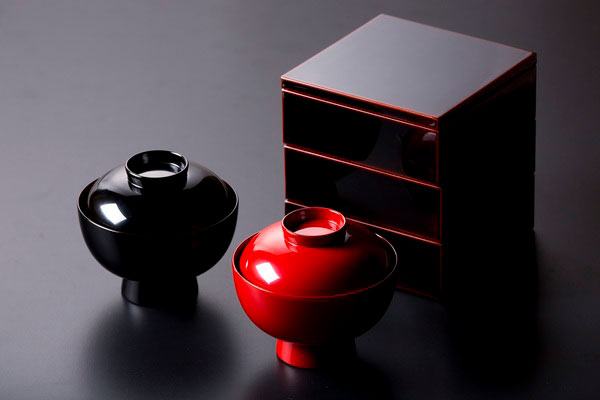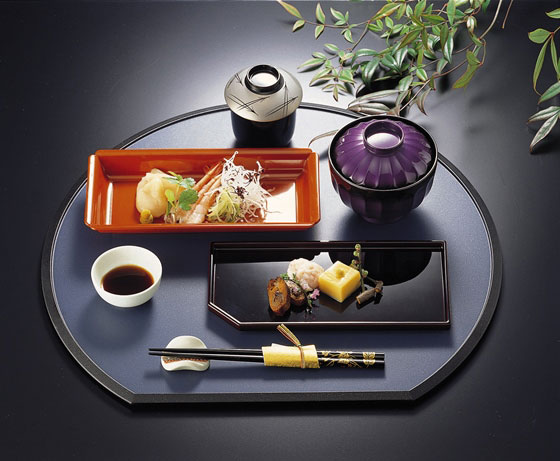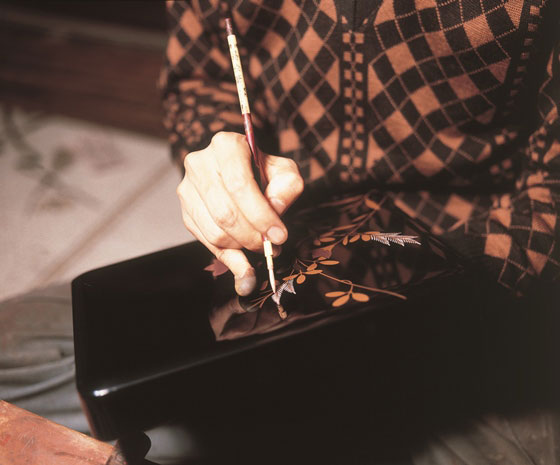
- Lacquerware
- Fukui
Echizen lacquerware Echizen shikki
Articles produced by groups of professional artisans
Beautiful coloring full of depth and serenity
Description
What is Echizen lacquerware ?
Echizen lacquerware (called Echizen shikki in Japanese) is produced in the area around the city of Sabae in Fukui prefecture. Lacquer is at the center of life in the Echizen district of Sabae, which is known as the city of manufacturing.
The notable aspects of Echizen lacquerware are its composed luster and refined brilliance which appeal to the people of Japan. That is why this lacquerware is often used for weddings and other events as well as the beautiful color combinations. As each process requires advanced techniques, they have been passed down throughout the generations. The production of these handicrafts starts with a group of lacquering masters called nushiya who are craftsmen that mainly work on the coating process, and the handicrafts are completed by dividing the workload among various experienced craftsmen. A huge variety of items are produced, from celebratory items, different kinds of boxes, tea utensils, chopsticks, and soup bowls.
Along with the changing lifestyles of Japanese people and market needs, Echizen lacquerware has developed diversified products and created technology for mass production. Today, Echizen ware represents more than 80% of the lacquerware for domestic food industry and business use. New styles of cutting-edge Echizen lacquerware continue to be released.
History

The history of Echizen lacquerware goes back to the end of the Kofun period (250-538) approximately 1500 years ago. When the 26th Emperor of Japan, was still the Imperial Prince, he came to Kawada in the Echizen domain, ordered repair work on his broken crown to be done by a lacquering master in the village of Katayama, modern-day Sabae. Subsequently, a black lacquered bowl was presented to the Imperial Prince together with the repaired crown. Impressed with its shape and quality, he is said to have sponsored the village of Katayama as a lacquerware-producing area.
During the time in which rice was paid as an annual tax, lacquer became a recognized alternative tax payment method in Echizen. Half of the domestic Japanese lacquer tapping was carried out in Echizen during its peak. Lacquer tapping workers used a technique to make a scratch on a lacquer tree in order to gather the lacquer liquid.
There are records from the time of the Nikko Toshugu Shrine construction (approximately 1617), that contain the names of Echizen workers who worked as lacquer tappers. Lacquer tapping being highly regarded by the Tokugawa shogunate (feudal military government, 1603-1867) and the popularity of Buddhist memorial services led to Echizen becoming the leading lacquerware producing area of Japan. Gradually, maki-e (gold lacquer in carvings) and chinkin (gold inlaid lacquerware) techniques were passed down, and solid and showy ornaments were added. During the Meiji period (1868-1912) various other products were produced, including small dining tables and flower vases.
General Production Process

- 1. Wood base production
Each process of Echizen lacquerware is detailed, and the nushiya is a labor-dividing organization that brings together artisans from production areas to make an item of lacquerware.
The first process is the choice of material. Wood base is what the lacquer will be applied to, so a solid tree, such as zelkova, horse-chestnut, cherry, or the bigleaf magnolia is chosen as the material. The wood is collected and made into wood bases. In order to produce a wood base without any warping, it is important that the raw timber used as the material is properly dried. The presence of a craftsman known as a woodturner is required to use a technique to finish with the correct measurements.
It is important to apply a first coat before sending the wood base for the coating process. The first coat produces the undercoating for the lacquerware, so any scratches, holes, or natural cracks in the wood base are to be filled in, and any brittle parts are to be reinforced. The condition of the coating of the lacquerware and its solidity is affected by the quality of the first coat. Circular objects such as bowls are trimmed using a lathe, while angled objects are made by cutting and shaving a board.
As the use of dishwashers increases, materials such as metals, plastics, glass and fibers are being increasingly used in addition to wood. Plastic molding is carried out by heat processing using machinery, which has enabled reduced costs and more diverse shapes. With the recent development of 3D printers, new styles have been introduced in addition to the traditional.
- 2. Undercoating
The coating process is split into undercoating and overcoating. The coating technique used is either hand coating or spray coating. A chemical reaction of the urushiol contained in the lacquer causes it to harden, so a high humidity is required. As the work is affected by the weather, it is a delicate process that requires many years of experience. Undercoating is a process that affects the quality of the lacquerware as coating so there is repeated polishing.
- 3. Overcoating
In order to create a glossy polish, overcoating is an important technique that dries the lacquer while maintaining the temperature and humidity. Spray coating is done with a manual spray or an automatic spray gun. Traditional colors or modern colors can be used, and kawari-nuri (meaning changed lacquer) and other new techniques have been developed.
The finished coated lacquerware is dried over a period of a few days in a machine called a rotation bath which rotates at fixed times. This ensures that dirt and dust do not attach to the lacquerware.
- 4. Maki-e
There are various decoration techniques used in Echizen lacquerware, but the most commonly used are mechanical printing and transcription techniques like maki-e and chinkin. Maki-e refers to the process of soaking a brush in lacquer, drawing pictures or patterns with the brush, and then coloring by sprinkling gold or silver dust before repeatedly polishing and refining. The three main techniques, depending on whether or not sprinkling and polishing have been done, are tokidashi maki-e (gold/silver lacquer polished to finish), hiramaki-e (flat gold/silver lacquer), and takamaki-e (embossed gilt lacquerwork).
- 5. Chinkin
Chinkin or gold inlaying is a process where patterns are etched into surfaces using a special knife. Gold or silver leaf as well as pigments, are applied to the etchings and coated with lacquer. The main techniques of gold inlaying are sen-bori (line engraving), ten-bori (point engraving), and katagiri-bori (sliced engraving).
Where to Buy & More Information
Fukui Ceramics Center
-
Address
-
Tel.+81-778-32-2174
-
ClosedMondays and the next day of holiday (except Saturday, Sunday and holiday), December 28 to January 4
-
Business Hours9am to 5pm
-
Website
See more Lacquerware
- Wajima lacquerware
- Kamakura-bori lacquerware
- Tsugaru lacquerware
- Aizu lacquerware
- Yamanaka lacquerware
- Kawatsura lacquerware
- Echizen lacquerware
- Joboji lacquerware
- Kiso lacquerware
- Hidehira lacquerware
- Kagawa lacquerware
- Ryukyu lacquerware
- Takaoka lacquerware
- Wakasa lacquerware
- Hida-shunkei lacquerware
- Ouchi lacquerware
- Kanazawa lacquerware
- Kishu lacquerware
- Kyo laquerware
- Odawara lacquerware
- Naruko lacquerware
- Niigata lacquerware
- Murakami carved lacquerware































































































































































































































































































